New address for this site: http://www.ChrisOwlCam.net/
Newer address for postcards, etc.: Chris W. Johnson, P.O. Box 302042,
Austin, TX 78703, USA
April 21 – 5:09 AM CDT –
Reasonably sure all four owlets were heard, three were definitely sighted, and two were kinda photographed.
(And both adults put in appearances, too.)
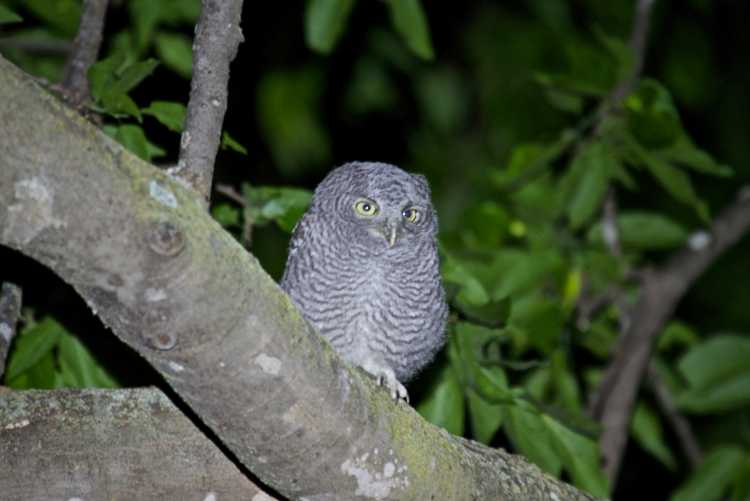
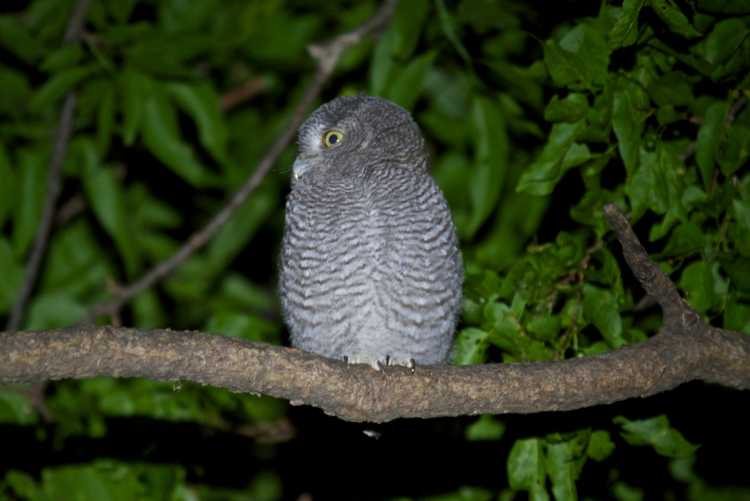
April 19 – 10:28 PM CDT –
All four owlets are safe. Just sighted three of them simultaneously, each within four or so feet of one another and all
in the same tree – just one big one along from the even bigger hackberry in which I was depositing them. The fourth
could be heard food begging from another more distant tree. The only thing wrong with both of these owlet-equipped
trees is that they aren’t in my yard.
One of the adults came to see me in response to my call. Like last night, there was no attack or threatening
behavior from the adults, so they must be satisfied that the owlets are mobile enough not be threatened by ground
dwellers like myself.
April 18 – 9:43 PM CDT –
I have yet to find an owl or owlet during the day, but, at night (the ideal time would be shortly after evening civil
twilight when the owlets are the most hungry) some patient listening does tell me where the owlets are as they
vocally beg their parents for food. Both tonight and on the 16th, I was able to identify three distinct sources of
food begging sounds. Tonight I even saw at least one, and probably two or three of the owlets. They are either
staying in the big hackberry tree into which I released owlets 3 and 4, or can move to that tree quickly and easily.
The adults are present, of course.
I’ll continue looking and listening. The fact that I haven’t heard more than three owlets at (roughly) the same
time doesn’t suggest anything has happened to one of them; the one that’s fed first won’t have much to say for a
while once its belly is reasonably full. So, unless I’m listening just before feeding starts on any given night,
it’s likely that I wouldn’t hear all of them.
I’ve also searched the yard at least once each day looking for fallen owlets (a prospect that, at this point, is
very unlikely, given their now well-practiced jumping/flapping/climbing skills), but I haven’t found any, nor any
signs of violence to one.
April 17 – 12:52 PM CDT –
I’ve run out of owlets (well, of conveniently boxed owlets), but still have a backlog of material, mostly motion
triggered color photos, that built-up in the last week. (To say nothing of an archive of short videos that I may
never find the time to examine.)
So, here, good viewer, have a movie from the 15th
(MPEG-4, 50.6 MB) in which one of the adults delivers
what appears to be a dead Texas Blind Snake to the nest, and then gets stuck in the nest by an owlet that has parked
itself in the entryway while her back was turned. (The audio hum was back with a vengeance when this video was
recorded, so I’ve done some filtering to remove most of it. That has some side effects, however, and that's why
things sounds a bit odd.)
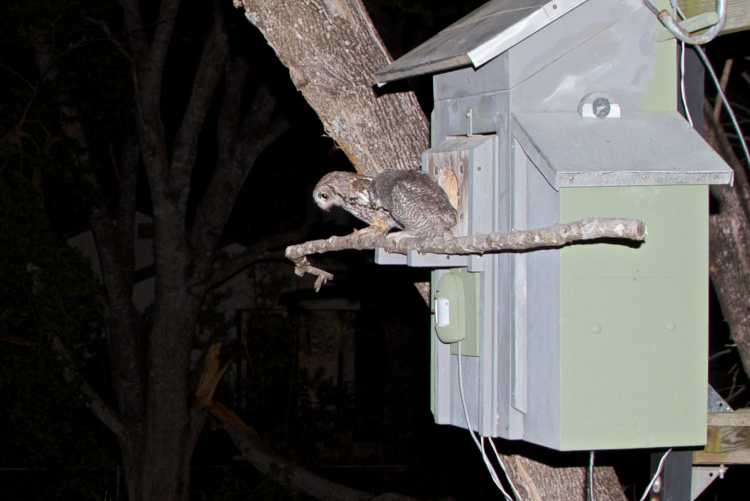
9:46 PM CDT: Owlet
no. 4 and parent on owlet rail.
April 16 – 10:50 PM CDT –
Owlet no. 4 departed while I was writing the previous update. I’d thought it would wait
until tomorrow night, but it had other ideas, especially after
watching intently the departure of owlet no. 3.
As soon as I noticed, I went out to
the nest box tree to look for no. 4. I couldn’t spot it anywhere in that tree,
but I was hearing loud food begging from some small trees on the far fence line. Although all the other owlets headed
for the nearby crepe myrtle tree, this one appears to have gone in the opposite direction, following a limb that
collapsed to the ground long ago, but without breaking off from the nest box tree, such that it forms a kind of long
arc down to the ground. The upper part of that arc is a favorite perch and meeting place for the adults as they come
and go from the nest box. From the point at which the limb reaches the ground, I think the owlet must have climbed some
of the small vertical branches at the end of the limb to a height that allowed it to easily leap into the small trees
on the nearby fence line, which is where I found it.
Deciding that those small trees provided little protection, and that it was best to keep the family together,
I collected my small friend from its perch in the little tree, and walked it over to the large
hackberry into which I’d placed owlet
no. 3 earlier in the evening. From the same point of departure, no.
4 chose a route along a convenient horizontal limb, rather than climbing vertically as no.
3 had done, but that limb happens to be a favored perch of the adult owls, so it’s in a good place. Both adults
watched the owlet and I with great interest, and from within ten feet, so they both know exactly where the owlet
is. (Of course, its food begging would have brought them to it, regardless.)
It’s been apparent from the start that this year’s Mme Owl was very familiar with
the nest box, and this year’s male wasn’t. There was also a peculiar combination of male and female pre-nesting
roles in Mme Owl: she not only would enter the nest box and go through the traditional
motions of forming a depression for eggs (an exclusively female role), but she would sit in the entryway and call
loudly and at length to attract a mate to the nest box (a male role). So, I believe this year’s Mme Owl was
also last year’s, while the male was a last minute recruit to replace her just lost mate, whose eggs I expect
she was already carrying, thus explaining the urgency of her nest site preparation and mate recruitment activities.
The upshot of all that is that one owl, I suspect, has been treating me as a harmless annoyance throughout
this nesting, while the other has been furious with me just for doing things like climbing a ladder to mount the
camera used for the motion-sensitive photography. I think the experienced female is the calm one, and the new male
is the furious one.
Whether that’s right or wrong, at least one owl was furious with me tonight, and the transfer of the second owlet in one night
brought on attacks to one side of my face, as well as the ear I like to keep around there, as I watched to make sure
that owlet no. 4 would successfully reach whatever destination it chose. In the end, they’re
nothing but tiny, shallow stab wounds, but they were certainly unpleasant at the time. Needless to say, whoever
attacked me was doing what instinct and experience combined to tell it was right and necessary, and, though I hope
experience will mitigate its attitude toward me in the future (ask the owlets – I’m harmless), I don’t blame it for
a moment.
That said, the next time I rush out into the yard to check on an owlet, I certainly won’t forget the protective
towel I’ve been in the habit of wearing over my head.
(Worn over the eyes, I recall, it would also be an effective defense against any Ravenous Bugblatter Beasts of Traal
that might happen along. Suddenly, I feel very froody, and much indebted to the late, great Douglas Adams. If you don’t
like his fiction, at least consider reading Last
Chance to See .)
.)
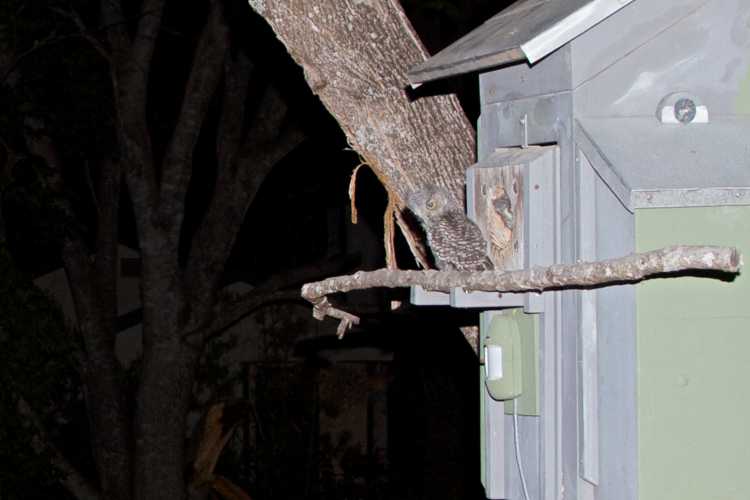
8:49 PM CDT: Owlet
no. 3 becomes a brancher
as no. 4 watches.
9:27 PM CDT –
Owlet no. 3 left the nest sometime within the last hour. I’ll determine the precise time
later. When it happened, I was too busy rushing out to the nest box tree to keep an eye on the owlet. Usually that’s
unnecessary, and the owlet was doing great through its first three big leaps, but its fourth leap failed and left it
on the ground at the base of the nest box tree. I introduced myself, made an awkward attempt at an ear rub, and
picked up my small friend. Its need to be free was evident; as comfortable as it was in hand, it flew off twice
before I could get it to the big hackberry tree at the back of my yard where its parents like to perch; the same
hackberry to which every generation of my owlets have ultimately been led by their parents.
Once we arrived, it took a while for my small, fuzzy friend to decide that the hackberry would make a better
perch than my hand, which is relatively soft (my hand, that is, compared to a tree), and puncturable, and therefore
provides good traction for perching. In the end, though, the instinctive desires to be free and to climb for safety
kicked in, and my tiny friend did an amazing job of scaling twenty or more feet of vertical trunk, before finding a
good perch in a V where the trunk divided.
During that process, both adult owls were on hand to observe. Well, one limited itself to observation; the other
thought I deserved some stern attacking, as well. Fair enough.
So that should be one safe owlet.
Naturally, I have looked for the other owlets that have left the nest, both directly and by looking for patterns
in the flight paths of the adults at night (to the extent that I can see them), but, so far, there’s only a hint
that the crepe myrtle tree might still be home to an owlet or two. I’d like to see them from time to time, just to
know they’re safe, but stealth is a basic owl survival skill, so I can’t read anything into my inability to find
them.
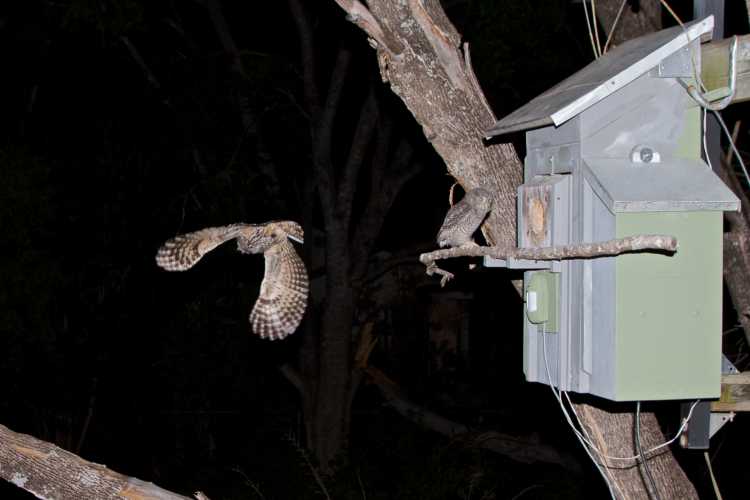
1:11 AM CDT: Owlet
no. 2 on the owlet rail
as parent departs after food delivery.
2:57 AM CDT –
Owlet no. 2 left the nest earlier this morning while my back was turned. As soon as I
realized what had happened I went out to the nest box tree to have a good look. The owlet had taken the sensible
route from the far end of the owlet rail to a nearby limb, and had then climbed to the jagged top of that
limb (the rest of the limb having broken off a year or more ago). That was a good vantage point for it, but not a
good point of departure for any of the limbs that would lead it to the neighboring crepe myrtle
tree. Eventually, it reached the same conclusion, and made rapid progress from limb to limb until, still perched
on a branch of the dead nest box tree, it was just barely amongst some upper, leafy branches of the crepe myrtle.
From there, it seemed hesitant to move.
Throughout this whole process, owlet no. 2 was issuing food begging sounds, and,
whether by coincidence or design, the adult owls delivered more food as it journeyed closer to the crepe myrtle
tree.
By the way, I searched visually by daylight, and have listened by night, for an indication of the whereabouts
of owlet
no. 1, but have found no clues. I doubt that anything bad has happened to that owlet;
my yard, thanks in large part to the disintegration of the nest box tree, is well equipped with sizable, dead limbs
that would provide any fallen owlet with good cover amidst the clutter of branches they create at ground level and
good perches among the branches directed skyward. My best guess is that it has, as the owlets do every year, made
its way to one of the two large, intertwined hackberry trees at the back of my yard, where it has been too well
fed (being the only owlet out of the nest until an hour or so ago) to reveal its location with vocalizations, and
too well hidden among the visual complexities of the tree canopies to be found visually.
April 14 – 11:15 PM CDT –
Between the time the first owlet leaves the nest (thus becoming a “brancher”), and all the owlets have left the
nest and begun to fly (thus becoming “fledglings”), the adult owls spend their nights operating in a hyper-defensive
mode that results in any potential threat that passes near a tree containing an owlet being warned with bill clapping
to go away, warned more severely with mock attack passes, and finally outright attacks, which are not unlike being
unexpectedly hit in the head with a well lobbed softball that happens to have needle-sharp talons.
Tonight, however, this clodhopper seems to have found a curious loophole in the rules: Go out on a pleasant night
when the sky is bright enough to make silhouettes of the trees, lay down in the grass between a favorite
screech owl perch and their nest, their branchers, or, ideally, all three, then watch and listen. The adults will
fly to and from the hunt and the nest answering the begging calls of owlets, they will fly to branchers with food,
they will pause on branches above you for long studies, they will fly silent and low just above you apparently without
ill intent, and they will also pause on favorite perches nearby and exchange songs with each other; the conversations
of owls. Call it anthropomorphizing, if you wish, but I recommend withholding judgement until hearing it yourself.
Tonight, while exploiting that loophole for several hours, I watched owlet no. 1
leap and climb, leap and climb its way through the nest box tree, and into the adjacent
crepe myrtle, which will provide it with good cover
during the day tomorrow. Silent arcs of migrating birds, their pale undersides caught in the city lights,
disappeared into the north one after another, crickets sang from all sides, light winds passed by, playing
in the grass as they went, and a few Alpha
Virginids even showed themselves.
Owlet no. 1 could hardly have chosen a better night for branching.
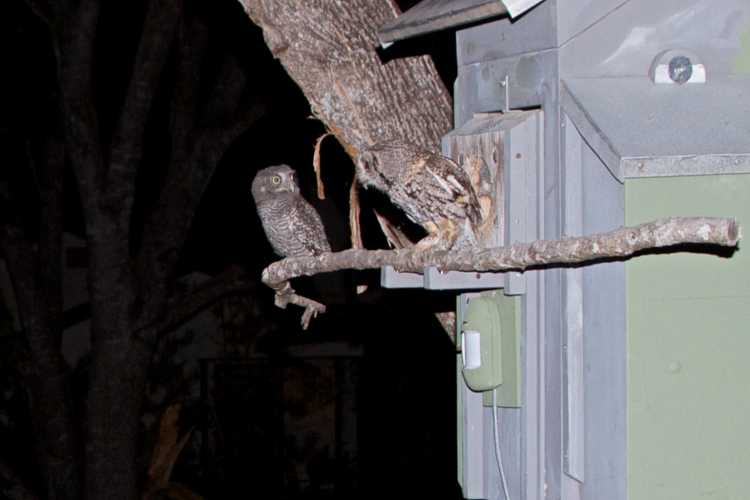
9:11 PM CDT: Owlet
no. 1 on owlet rail with parent.
9:35 PM CDT –
Owlet no. 1 left the nest box an hour or so ago. As soon as I noticed it disappearing
into the entry hole (or exit hole, in this case), I went outside to watch it. It spent a long time on the owlet
rail evaluating its options, and even being fed a time or two by mom and dad. Then it executed a perfect jump to
a limb near the far end of the owlet rail, climbed as high as it could on that limb, and leapt across the gap
to another limb, clambered up that to a small branch, and stayed there so long I had to give-up my watching.
I assume it’s still there, contemplating its next move, and, I’m sure, hoping for a food delivery or two. I’ll be
doing my best to check on its whereabouts throughout the night.
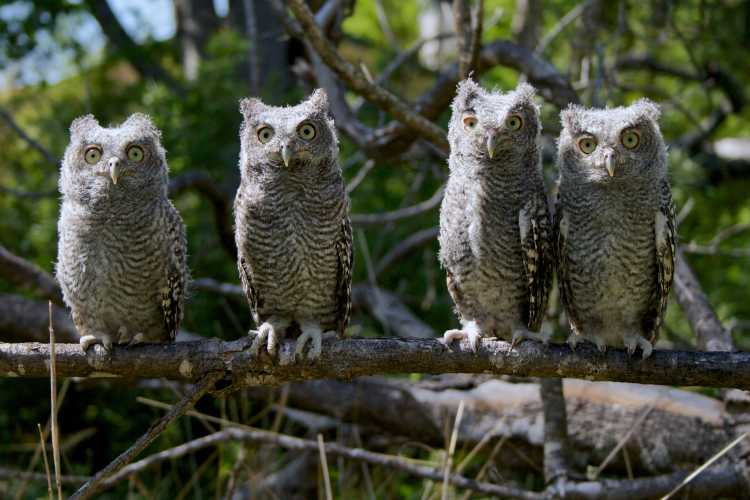
2013 Owlet Family Portrait.
Left to right: Owlet 4, 2, 3 and 1.
4:30 PM CDT –
Busy afternoon. The nest box was taken down in order to install the owlet rail, and to clean the side and
attic camera compartment windows. (The view from the attic
camera is looking rather odd at the moment, and
I'm not sure what I could have done to cause the change. Nonetheless, it's still more than good enough for
owlet counting, which, for me, is its primary use. I power-cycled the attic’s video modem and now the
picture is better than ever.)
Of course, I also took the opportunity to take photos and video of the owlets. Ordinarily, I’d spend an
hour or more photographing them, but this year I had the able assistance of friends M and M, which changed
the situation unexpectedly. Between the three of us, all of the owlets received so many ear rubs, and had
the feathers of their heads and bellies delicately stroked, that all of their fear was quickly replaced with
contentment and excitement at the opportunity to take in all the sights and sounds of the world they’re
soon to inherit. That was wonderful to see. The unexpected complication it introduced was that the owlets felt
so comfortable in their new situation, with mom and dad calling to them and swooping overhead, and their three
new people friends there to look out for them, too, that they wouldn’t sit still for their photos; they
fearlessly went flapping off to new branches (their first chance to try-out their wings), climbing to
get even better views of their world, etc. So, owlet wrangling became a major task, and getting the photos
and video I wanted for the owlet family portrait became problematic since the owlets kept flying out of shot.
It was a pleasure seeing them take in all the new sights and sounds, so enthusiastic and carefree. If it
ruined the shoot, perhaps I can try again tomorrow, provided nobody flies the coop tonight.
I haven’t even begun to review the photos and video, but, with luck, there’ll be some good material in
there despite, or because of, the frolics of my tiny feathered friends.
More later.
Update: I have reviewed some of the video, and I screwed-up. Ordinarily, I only shoot video in 1080p,
so I was sure the camera was set for 1080p recording. In fact, it was set for 640 x 480 resolution (a leftover
from a squirrel box monitoring experiment months ago), which is a big disappointment. (Note to self: always
double-check all of the settings.) The video may still prove interesting, but, by modern standards it will
be disappointingly tiny. I really should not have been dumb enough to make that mistake.
April 12 – This update ran late because I had my
SLR setup for motion-sensitive shooting starting shortly before
sunset, and between then and midnight it captured 184 photos of the owls, including twenty six that I thought
were worth including in the update. It takes time to sift through all of that material and then
prep the good shots. Ideally, I’d make sure that any video frames relevant to the
photos were also included, but haven’t. It’s one of those “have to draw the line somewhere” days.
It appears that every owlet can now climb into the entry hole, but none are going very far into its three inch
depth, so their primary goal in doing so, at least at night, is to grab all of the food deliveries until they’re
full, at which point they go have a rest on the nest box floor, and some other owlet moves into entry hole. You'll
see them in a number of the photos either waiting for, or receiving, food. (When they sit in the entry hole during
the day, it’s to take in the sights and sounds.)
Tomorrow afternoon I anticipate bringing down the nest box for the annual attachment of the owlet rail, and
owlet family portrait. The weather forecast is favorable, and it doesn’t look like the owlets are anxious
to leave the nest between now and then (fingers crossed), so I hope to have some good owlet photos for you in
the April 14 update.
By the way, to safeguard against future hosting problems, such as those that kept this site down for two and a
half weeks earlier this season (my thanks, once again, to everyone whose emails, etc. fixed that problem), I’ve
registered the domain “www.ChrisOwlCam.net”. Currently, that address just takes
you to good, old “gargravarr” at UT Austin, but it could take you to an alternate host in the future. I suggest
bookmarking that address. I hate to make less obvious UT Austin’s involvement, by kindly allowing use of “gargravarr”
as the host for this project, but the same person who brought the site down this year, may cost me my job at
UT Austin, just for the fun of it. (Yeah, I realize how ridiculous that sounds.)
April 10 – There’s been a lack of clarity
in the lower portion, especially on the right, of the images from the side video camera. It's a safe bet around this
time in nesting that enough wet adults have hit the window in front of the camera with their wings, and enough
inquisitive
owlets have poked, prodded, and even tried to climb that same window, that some grunge has accumulated. Therefore,
during a lull in the food deliveries at 5:33 AM, I brought the box down to clean the window, and, I thought, to
take some owlet photos. The box came down, I opened it up, found what I expected: four owlets playing dead.
But one was ruining the effect by adding bill clapping sounds to its “dead” impression. Giving it an ear rub would
quiet it (and seem put it to sleep, like rubbing a dog’s belly), but it would always open its eyes again and
start the bill clapping sounds. Since those indicate agitation, I though it best to calm that owlet, lest it keep
all of the other owlets on overly high alert.
So I removed that one owlet, and set about convincing it that it was safe; letting it perch on my hand for
ear rubs, perch on the door of the nest box a hand’s length from its siblings, perch on my knee as I sat cross-legged
in the grass, and let it take in the view of the world (which included one or more of its parents attacking me,
something the owlet did not appear to judge as especially interesting), make a few experimental hops through the air to try out
its wings (they work, but don’t yet generate enough lift to keep the owlet aloft), and make a half-hearted try at
swallowing one of the two small-ish mice I’d brought with me. (In the end, I placed the mice in the box, just before
returning it to the tree, and several owlets subsequently tried very hard to eat them, although
Mme Owl probably had to tear them apart before any eating actual took place.)
The owlet
rapidly stopped responding to me with anything like fear. Instead, it calmly enjoyed the sights and sounds and
completely ignored the fact that it was taking them in while perched on an enormous monkey (enormous by screechlet
standards). It also continued to make bill clapping sounds whenever it wanted. It made them, I think, like idle
commentary, about which it expected no action.
So, did removing that owlet from its siblings and turning a three minute window cleaning into a seventeen minute
“get to know you” session do anything to keep my tiny friend from making its siblings more stressed? I think so, for
two reasons: (1) while playing dead, it’s siblings were watching our harmless interactions, and (2) as soon the box
was back in the tree, “my” owlet was the first to stand up, which signalled to its siblings that they didn't have to
play dead anymore, and it promptly climbed into the entry hole to get itself more of that outside world view.
The photos, and to avoid disturbing the other owlets I’d’ve settled for one shot of “my” owlet on my knee,
didn’t happen because it started to rain as I was reaching for the camera. I’ll just have to try to hold on to
that memory.
So, if you saw the box open this morning, and an owlet gone, that’s what was happening. If you happen to catch
it in the twelve hour delayed images later this afternoon, that’s what’s going on.
After all of that, the picture is clearer, but not, I think, as clear as it should be, which would suggest some
dust has accumulated on the inside surface of the side camera compartment’s window. If I get worked-up about it,
you may witness a repeat performance at some point. I wonder, should that happen, if there’ll be one owlet less
interested in playing dead, and more interested in coming outside for a look ’round.
April 9 – The owlets are climbing well, with at
least one able to climb entirely into the entryway. It’s almost a mystery to me that they’ve grown to this point,
due to the lack of large food items, but, in this case, at least, quantity does seem to have made up for quality.
April 8 – Some more motion triggered photos of
the adults can be found amongst the pre-dawn video frames, specifically between 1:08 and 5:17 AM.
April 7 – We now have at least two climbing owlets,
one of which is capable of placing its head above the lower lip of the entry hole, so it can peer out at the
heretofore unseen outer world.
Mme Owl left the owlets alone for a portion of the day again, but this time waited
until 4:26 PM CDT to make her exit.
No motion-triggered color photos today. I had the camera setup, but the feature of the camera lens that’s
meant to allow manual focus to be locked, such that it can’t even be changed manually, turns out not to work
all that well. Therefore, everything shot was uselessly out-of-focus. One more lesson learned the hard way. The
camera is operating as I write this (3:53 AM), so, all things being equal, there should be some new shots in
tomorrow’s update.
April 6 – With no apparent practice attempts,
one of the owlets reached the perch for the first time today, around 1:20 PM CDT.
Climbing attempts (or, in this case, successes) are an important sign of developing skills, and an active
interest in the outside world; an interest, it must be said, is present pretty much from the get-go.
Nonetheless, a successful climb to the perch, gives an owlet it's first glimpse of the outside word, as it
peers at whatever little piece of it is visible through the entry hole. This owlet (presumably the eldest)
did quite a lot of peering.
Another important owlet development, in both senses of the word, is the steadily increasing number of
wing-flapping exercises being conducted. Though occasional wing flapping can be seen among much younger
owlets, at this point they have a lot more to flap, and feel a compelling need to do so, presumably to
develop their flight muscles, even as they wait for their first set of flight feathers to grow into something
potentially useable.
Meanwhile, as has become common over much of the last week, Mme Owl left the nest
box in the early afternoon (1:47 PM on this day) and didn’t reappear until she began making food deliveries after
night set in.
April 4 – Due to the low temperature,
Mme Owl spent the day in the nest with the owlets, but still chose
to leave them at nightfall in order to hunt. Evidently, food is judged as a more urgent need than
warmth when the choice arises.
The mice from 7:20 AM, by the way, were eventually noticed by Mme
Owl—who seemed put off for quite a while by the disturbances resulting from their injections into her
nest—and were fed to the owlets. At this stage, however, I expect that two mice don't go far in feeding
the owlets. Still, better than nothing.
The prey items being delivered by the adults have all been small insects as far as I can tell; moths,
june bugs, crickets, and the like. The weather is currently too cold for geckos to be active, and the
area is still wet from the other night’s rains, which makes it harder for the owls to find ground dwelling
prey, since it makes far less noise as it moves through wet grass, leaves, etc. than it would if moving
through those same materials when they are dry.
7:20 AM CDT – Injected two mice into the nest
box after Mme Owl had returned for the day. The owlets seem to be subsisting on
small prey items and in need some more substantial prey. They are food begging as I write this.
My thanks for postcards go out to Nancy O. & Sandra M., as well as ever reliable Nancy C.
April 2 –
I’ve been overdue in trying out my motion sensitive photography on the owls this year, as a follow-up to one
night of experimentation last year. So, after a lot of work to make the motion sensor something I could remotely
attach and detach from the nest box, building a tool for that purpose, and debugging a remote control pig-tail
whose overly fine wires had broken in multiple places, I began installation of the rig around midnight of April 1/2.
With the camera equipment about 9 feet away from the nest box (though not in the nest box tree), the owls
decided I was a nest site predator, despite our prior good relations, and somewhere on my neck and head I have
multiple sets of talon marks to prove it. (One of these days, I must acquire a good hat.) Nonetheless everything
was ultimately installed, and the camera operated from around 1:30 to 6:30 AM CDT.
One hundred forty nine photos were obtained that included an owl, of which 18 seem worthy of display (for one
reason or another). You’ll find them mixed into the April 2 daily slide show in
chronological order, along with the usual nest box interior images. You’ll start finding them at 2 AM, and stop
finding them after 6:15 AM. (Note: Clicking on those images in the slide show will cause a larger version to be
displayed.)
It’s clear to me that there’s still debugging needed in this setup. The sensor’s field of view seems to favor
shots of the owls after they’ve dropped out of the nest box entry hole (leaving backwards, more often than not, in
a process I have not seen, let alone caught on “film”), and are aggressively working to regain flight. Also, the
focus is soft despite carefully locked focus that was based on direct measurements of the scene, and some time spent
with a depth-of-field calculator. The same steps produced good focus for last year’s experiments, so obtaining
good focus ought to be possible, even straightforward.
Desperately as we need the rain that kept Mme Owl in the nest box during the day today,
its timing was inconvenient for me, in as much as it prevented any further experiments on the night of April 2/3,
and the forecast indicates that it may well interfere with an attempt on April 3/4. Nonetheless, I’ll get other
chances, and should be able to work out the problems (or learn to work with them to reasonable effect).
April 1 –
Mme Owl, having left the nest (see below) returned to
after an absence of two hours, eighteen minutes. Then she exited again a few
minutes later. She didn't return in earnest until 6:00 PM CDT,
after which she remained in the nest until 8:05 PM, fourteen minutes after
sunset,
and ten minutes before evening
civil twilight. From then to midnight (and after), it was all hunting, all the time;
she and her mate stopped by the nest only to make food deliveries.
12:51 PM CDT –
Mme Owl exited the nest box after spending some time sitting in the entryway, either
making sure the coast was clear, or that there was something worth trying to capture out there, or both.
(Temperatures in the nest box, worst-case, are in the low- to mid-eighties Fahrenheit, so I don’t think she left for
that reason.) She hasn’t returned thus far, so I’m guessing that if it was a bit of opportunistic hunting, it failed
(though that leaves open the question of why she hasn’t returned to the nest – fleeing from mobbing songbirds is one
possibility).
For whatever it’s worth, she’s done this at least once before, though I’ve failed to remark on it (yes, I’m an
oaf). Specifically, she was out of the nest from 1:10 to 1:19 PM CDT on
March 27th. The temperature on that occasion was 70° F,
so thermal discomfort seems unlikely to have been her motivation.
BTW, I saw my first hummingbird of the year today, humming around my stand of
Turk’s Cap (Malvaviscus drummondii) so
spring must have truly sprung, and the return migration is in progress.
March 31 – 7:07 PM CDT –
Unexpected real-time news from Google Analytics gives rise to a message that it never occurred to this
child of Apollo he'd write:
Welcome to the screech owl cam’, crew and (I assume) controllers of the
International Space Station. Enjoy.
добро пожаловать в веб-камеру восточной североамериканской совки команде (и – мне кажется – управление)
международной орбитальной станции!!
—[ Previous News Items ]—
